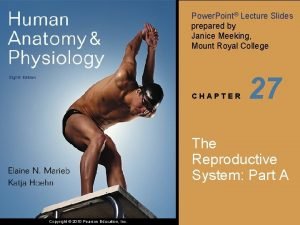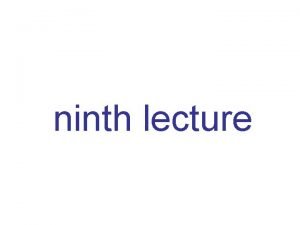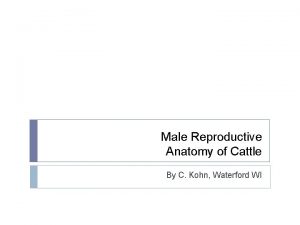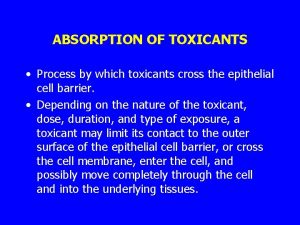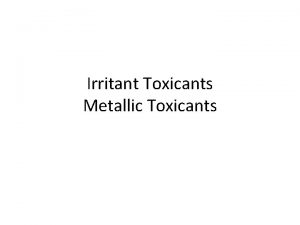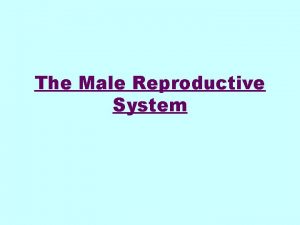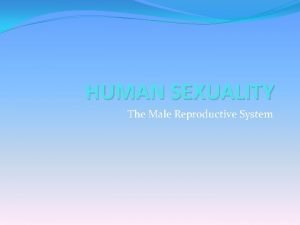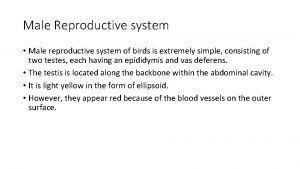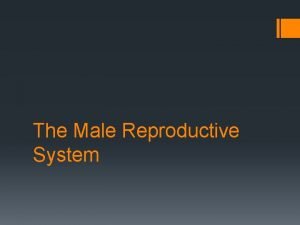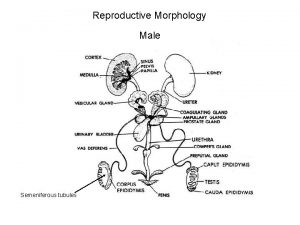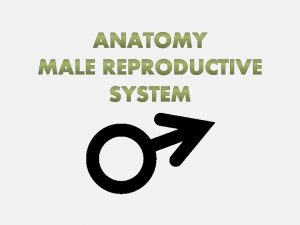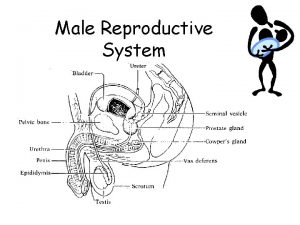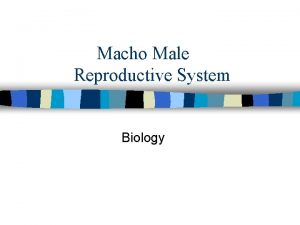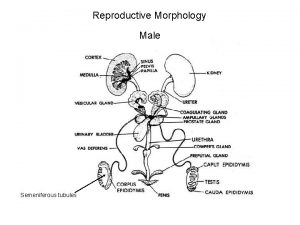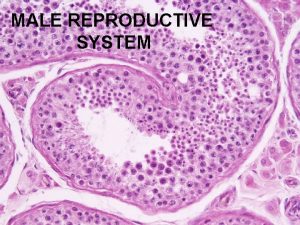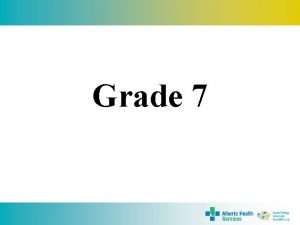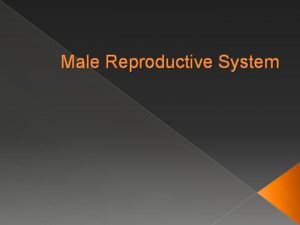Identification of key characteristics of male reproductive toxicants



















- Slides: 19

Identification of key characteristics of male reproductive toxicants as an approach for screening and sorting mechanistic evidence Xabier Arzuaga, Erin Yost, Brandy Beverly, Andrew Hotchkiss, Catherine Gibbons Photo image area measures 2” H x 6. 93” W and can be masked by a collage strip of one, two or three images. The photo image area is located 3. 19” from left and 3. 81” from top of page. National Center For Environmental Assessment, ORD, U. S. EPA Each image used in collage should be reduced or cropped to a maximum of 2” high, stroked with a 1. 5 pt white frame and positioned edge-to-edge with accompanying images. National Toxicology Program, NIEHS 4 th International Symposium on Systematic Review and Meta-Analysis of Laboratory Animal Studies 1

Presentation outline • Systematic review and utility of literature inventories. • Development of literature toxicological inventories for experimental studies on PCB-induced male reproductive effects. • Development of literature mechanistic inventories for in- vivo and in-vitro studies on PCB-induced male reproductive effects. The views expressed in this presentation are those of the author and do not necessarily reflect the views or policies of the U. S. EPA. 2

Systematic review: Development of a database inventory • The goal of developing a literature inventory database is to facilitate subsequent review of individual studies or sets of studies by topic-specific experts 3

Challenges of evaluating toxicological and mechanistic evidence • Large databases. E. g. PCBs § > 324 reproductive studies § > 353 developmental studies • Complexity of database. E. g. PCBs § Diversity of experimental designs § Multiple congeners (co-planar & non-coplanar) § Multiple types of mixtures (high & low chlorinated) 4 4

Informational categories used to develop a database inventory on PCB-induced male reproductive toxicity • Citation information: authors, publication year, reference number, etc. • Experimental design features: exposure route and dose, species and strain of animals, test compound(s), age/lifestage at exposure, etc. • Types of outcomes… routinely evaluated effects. 5

Categories for male reproductive outcomes Male specific endpoints of reproductive toxicity (U. S. EPA, 1996) Organ weights Testes, epididymides, seminal vesicles, prostate, pituitary Visual examination and histopathology Testes, epididymides, seminal vesicles, prostate, pituitary Sperm evaluation* Sperm number (count) and quality (morphology, motility) Sexual behavior* Mounts, intromissions, ejaculations Hormone levels* Luteinizing hormone, follicle stimulating Developmental effects* Testis descent*, preputial separation, sperm production*, ano-genital distance, structure of external genitalia* *Reproductive endpoints that can be obtained or estimated relatively noninvasively 6 with humans.

Inventory categories for toxicological evidence reported in experimental studies (male tox) Citation information Experimental design Organ weight Function Evidence reported in experimental studies (toxicology and mechanisms) Hormone Behavioral Developmental effects 7 Histopathology Mechanisms-MOA relevant evidence

Challenges of evaluating mechanistic evidence • Few methods for identifying, organizing, and summarizing toxicological and mechanistic data for specific hazard domains. • The key characteristics of carcinogens provide a “basis for an objective approach to identifying and organizing results from pertinent mechanistic studies. ” (Smith et al 2016. EHP: 124[6] 713 -721) 8

Identification of key characteristics of male reproductive toxicants • Evaluated the review literature on mechanisms associated with chemical-induced male reproductive toxicity to identify established cellular/molecular pathways. • Types of review literature considered: – Book chapters, – Review papers, – Publications from scientific organizations 9

Literature search and review Pub. Med Web of Science Title and abstract review Excluded Supportive information - General biological/endocrine mechanisms - General reproductive functions Established mechanismspathways for known male reproductive toxicants. Additional Strategies: • Forward and backward searches (Web of Science) 10

Key characteristics of male reproductive toxicants Altered repro hormone levels-production Altered hormone receptor functions Altered cell signal transduction Altered male repro organ development/function Altered germ/somatic cell proliferation, differentiation, or death, functions 11 Altered epigeneticsgene imprinting DNA/chromosome damage Altered reactive oxygen species levels – ROS damage All/any of these effects occurring in pituitary-gonadal axis

Pathways captured in key characteristics • The key characteristics are properties that established male reproductive toxicants commonly show and may include multiple mechanisms. • “They are not mechanisms… nor are they adverse outcome pathways”. (Smith et al 2016) Example: Alterations in hormone levels and production Chemical Know mechanism-pathway associated with Citation(s) adverse male reproductive outcomes Phthalates (plasticizers) Reduced of steroid synthesis; decreased expression of steroidogenic enzymes Hotchkiss et al 2008 [1296663]; WHO 2012 [1597561] Ketoconazole (pharmaceutical) Reduced of steroid synthesis; inhibition of CYP 17 A 1 activity Dent et al 2015 [3452649] Prochloraz (fungicide) Reduced steroid synthesis; inhibition of CYP 17 activity Hotchkiss et al 2008 [1296663]; Scott et al 2009 [673313] 12

Example: Preliminary review of available evidence on PCB-induced male reproductive effects Mechanistic studies using commercial PCB mixtures 3% 3%3% Aroclor 1016 8% Aroclor 1221 3% Aroclor 1232 13% 3% Aroclor 1242 Aroclor 1248 Aroclor 1254 Aroclor 1260 64% Clophen A 50 Kanechlor 500 13

Preliminary review of available evidence (continued) Mechanistic studies that use Aroclor 1254 Cell proliferation/ differentiation/ death 7% 7% DNA-chromosome damage 2% Oxidative stress 27% 36% Hormone receptor binding-levels 20% Hormone levelsproduction Other 14

Preliminary review of available evidence (continued) Aroclor 1254 studies that report on reproductive hormone levels/production Gestational exposure studies 20% 33% Exposures during post-natal life stages In-vitro studies 47% 15

Advantage of developing inventories for toxicological and mechanistic evidence • Provides a tool for navigation of all (or most) of the available evidence for specific outcomes. • Improves transparency. E. g. What is the evidence on PCB exposure and altered hormone receptors? Go through available studies captured in literature searches. 16 Sort evidence according to categories created for inventory.

Next steps for key characteristics of male reproductive toxicants: • Complete description and examples for each of the key characteristics. • Complete database-inventory for PCBs. • Approach that can be used in the evaluation of any chemical. 17

Acknowledgements • Erin Yost (EPA), • Kris Thayer (EPA), • Andrew Hotchkiss (EPA), • Vincent Cogliano (EPA) • Catherine Gibbons • Beth Gatling (EPA), • Brandy Beverly (NTP), 18

Thank you! Xabier Arzuaga. Xabier@epa. gov 19
 Function of vagina
Function of vagina Reproductive hygiene
Reproductive hygiene Female testes
Female testes Anatomy of the reproductive system exercise 42
Anatomy of the reproductive system exercise 42 Oogenesis process
Oogenesis process Diagram of male reproductive organ
Diagram of male reproductive organ Female and male reproductive system
Female and male reproductive system Figure of male reproductive system
Figure of male reproductive system Reproductive physiology
Reproductive physiology Reproduction system of plants
Reproduction system of plants Art-labeling activity: the male reproductive system, part 1
Art-labeling activity: the male reproductive system, part 1 Male reproductive system information
Male reproductive system information Reproductive organ
Reproductive organ Male reproductive system
Male reproductive system Seminal vesicle
Seminal vesicle Male reproductive system plants
Male reproductive system plants Function of male reproductive system
Function of male reproductive system Cartilaginous fish reproduction
Cartilaginous fish reproduction Male reproductive system of pila
Male reproductive system of pila Fetal pig diagram labeled answers
Fetal pig diagram labeled answers










